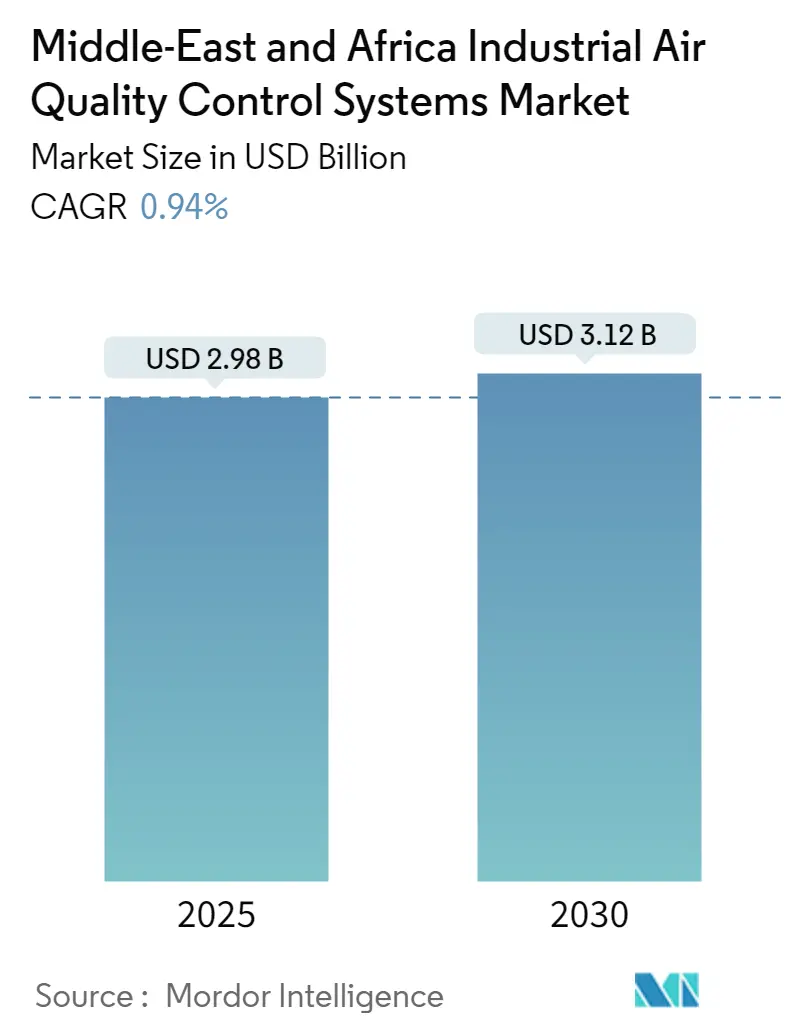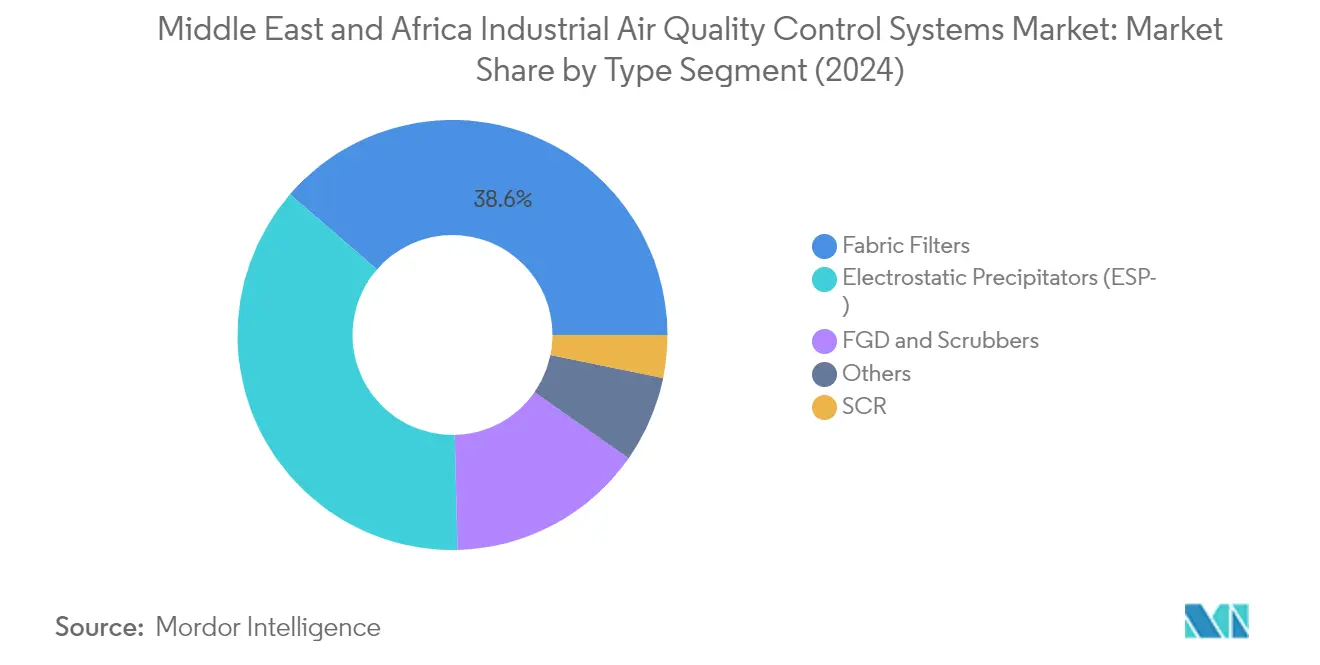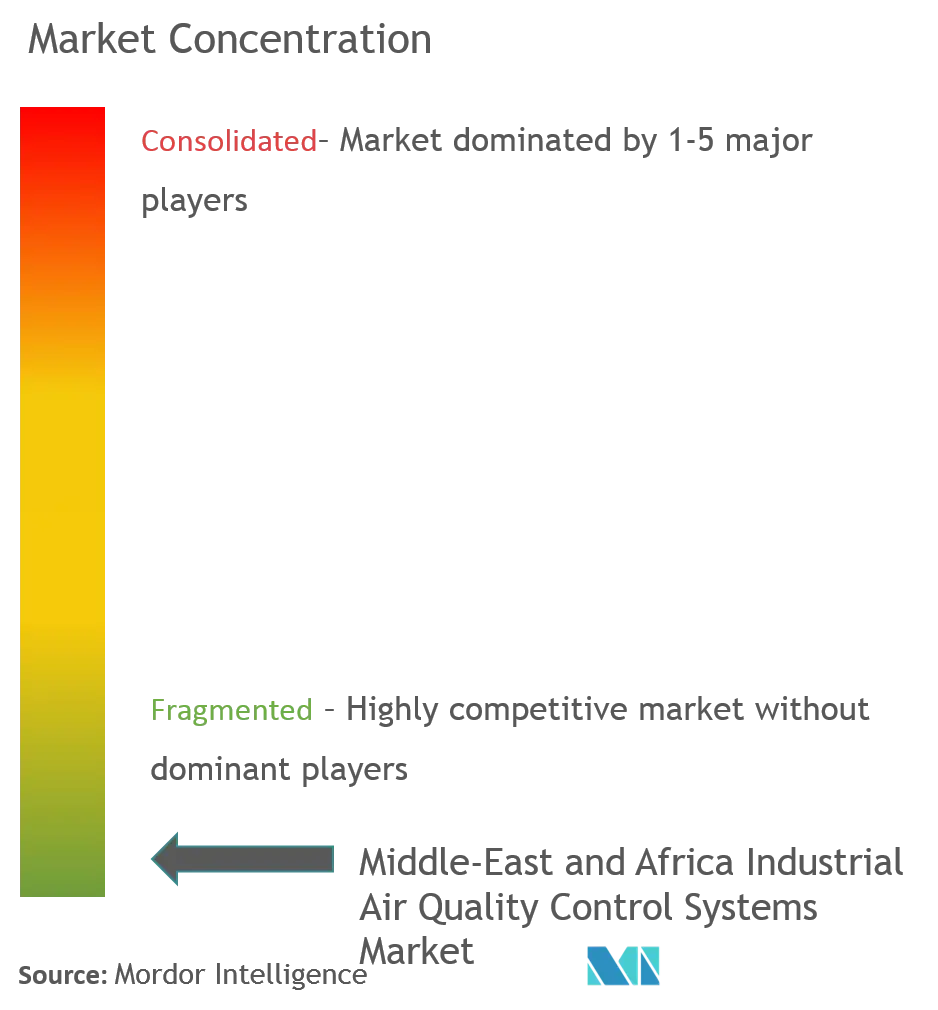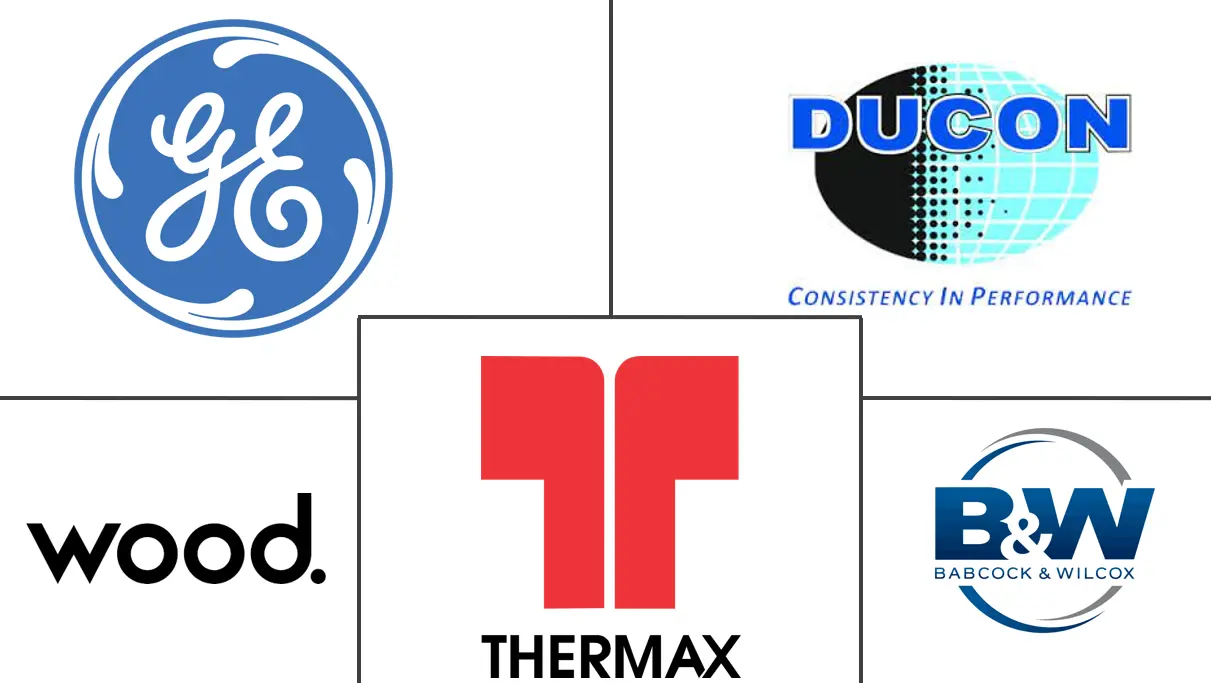
Middle-East and Africa Industrial Air Quality Control Systems Market Analysis by Mordor Intelligence
The Middle-East and Africa Industrial Air Quality Control Systems Market size is estimated at USD 2.98 billion in 2025, and is expected to reach USD 3.12 billion by 2030, at a CAGR of 0.94% during the forecast period (2025-2030).
The Middle East and Africa industrial air quality control systems market is experiencing significant transformation driven by increasing industrialization and stringent environmental regulations. The region's heavy reliance on fossil fuels for power generation continues to shape the market landscape, with natural gas accounting for approximately 58.3% of the region's electricity generation mix, followed by oil at 17.4%. This energy mix, combined with rapid industrial expansion, has created a pressing need for advanced industrial air pollution control systems across various sectors. The implementation of stricter emission standards and environmental policies, particularly in Gulf Cooperation Council (GCC) countries, has further accelerated the adoption of these systems.
The petrochemical and refining sectors remain crucial drivers of the market's evolution, with significant investments in new facilities and expansion projects. The Middle East's refining capacity reached 10.8 million barrels per day in 2021, highlighting the region's substantial industrial scale. Notable developments include Kuwait's Al-Zour Refinery, which commenced operations in 2023 with a capacity of 615,000 barrels per day, making it one of the world's largest refineries. Additionally, Africa's largest refinery, the Dangote Refinery in Nigeria, is set to begin commercial operations, further driving demand for industrial air pollution control systems.
The metals and mining sector represents another significant market segment, with major steel-producing countries implementing stringent air quality measures. In 2022, Turkey and Iran emerged as leading steel producers in the region, with outputs of 35.1 million tonnes and 30.6 million tonnes respectively. The industry's commitment to environmental sustainability is evidenced by increasing investments in green steel production, with companies like Jindal Shadeed Group announcing plans for a USD 3 billion green steel plant in Oman, incorporating advanced industrial pollution control equipment technologies.
Environmental consciousness and regulatory compliance are becoming increasingly important across the region, with countries setting ambitious emission reduction targets. The United Arab Emirates has established a goal to reduce greenhouse gas emissions by 31% by 2030, while Saudi Arabia aims to achieve net-zero emissions by 2060 through a USD 180 billion investment program. These environmental commitments are driving the modernization of existing industrial facilities and the implementation of advanced industrial air quality monitoring systems, particularly in power generation, cement production, and chemical manufacturing sectors. The trend towards sustainable industrial practices is expected to continue shaping market dynamics, with a growing emphasis on efficient and environmentally responsible industrial air treatment systems solutions.
Middle-East and Africa Industrial Air Quality Control Systems Market Trends and Insights
Demand from the Downstream Industry
The downstream industry, particularly oil and gas refining and petrochemicals, represents a significant driver for industrial air purification systems in the Middle East and Africa region. The refining process involves various chemicals that result in the release of toxic gases into the atmosphere, including nitrogen oxides, sulfur dioxide, and particulate matter, which must be carefully monitored and controlled due to their negative impact on human health and the environment. The Middle East, home to six OPEC member countries, has emerged as a major hub for downstream operations with 53 operational refineries having a total capacity exceeding 10 million barrels per day. According to BP Statistical Review of World Energy 2022, the Middle East accounted for 10.6% of the world's total refining capacity, while Africa represented 3.2% in 2021, highlighting the significant scale of downstream operations requiring industrial clean air systems.
The demand for industrial air scrubber systems is being further amplified by substantial new investments in the downstream sector across the region. In December 2022, Saudi Aramco and TotalEnergies made a final investment decision to develop a world-scale petrochemical facility in Saudi Arabia, featuring a mixed feed cracker capable of producing 1.65 million tons of ethylene annually. The project, valued at approximately USD 11 billion, demonstrates the region's commitment to expanding its downstream capabilities. Additionally, Iran has announced plans to build eight new petro-refineries in conjunction with the private sector, aiming to double output in the downstream sector. These expansions, coupled with the increasing focus on environmental regulations and the need to control emissions from these facilities, are expected to create substantial demand for industrial air purification systems during the forecast period. The growing investment trend is further evidenced by collaborative efforts such as the memorandum of understanding signed between Aramco, SABIC, and Sinopec in December 2022 to explore the economic and technical feasibility of establishing a new petrochemical complex in Yanbu, Saudi Arabia. The integration of industrial ventilation systems in these projects is crucial to maintaining air quality standards.
Segment Analysis: Type
Fabric Filters Segment in Middle East and Africa Industrial Air Quality Control Systems Market
The Fabric Filters segment dominates the Middle East and Africa industrial air quality control systems market, holding approximately 39% of the market share in 2024. This significant market position is attributed to fabric filters' superior efficiency in removing fine and ultra-fine particulates from industrial emissions. These systems are widely adopted across various industries, including cement manufacturing, metal processing, chemical production, and power generation facilities. The segment's dominance is further strengthened by the increasing focus on achieving higher filtration efficiency, with fabric filters capable of removing particulates as small as 0.2 microns with up to 99.9% efficiency. The technology's ability to handle high-temperature gases up to 1000°C, along with features like reduced maintenance requirements and longer operational life, has made it particularly attractive for industrial air filtration systems applications in the region.

Selective Catalytic Reduction (SCR) Segment in Middle East and Africa Industrial Air Quality Control Systems Market
The Selective Catalytic Reduction (SCR) segment is emerging as a rapidly growing segment in the Middle East and Africa industrial air quality control systems market, projected to grow at approximately 1% during 2024-2029. This growth is primarily driven by stringent nitrogen oxide (NOx) emission regulations and the increasing deployment of diesel power plants in the region. The segment's growth is further supported by the technology's ability to achieve NOx reduction efficiency of up to 90-94%, making it particularly valuable for industries striving to meet strict emission standards. The expansion of SCR systems is also boosted by their integration in hybrid projects combining renewable energy with diesel engines, particularly in countries like Egypt and Libya, where new power generation projects are incorporating SCR technology for industrial air pollution control.
Remaining Segments in Type Segmentation
The remaining segments in the market include Electrostatic Precipitators (ESP), Flue Gas Desulfurization (FGD) and Scrubbers, and other technologies. ESPs continue to maintain a strong presence in the market due to their effectiveness in handling large gas volumes and ability to operate at high temperatures. The FGD and Scrubbers segment plays a crucial role in sulfur dioxide removal, particularly in marine applications and industrial processes. The Other segment, which includes technologies like mist collectors and selective non-catalytic reduction systems, serves specific niche applications across various industries. These segments collectively provide a comprehensive suite of solutions for different industrial air pollution control requirements, catering to diverse industrial needs across the Middle East and Africa region.
Segment Analysis: Application
Power Generation Segment in Middle East and Africa Industrial Air Quality Control Systems Market
The power generation industry continues to dominate the Middle East and Africa industrial air quality control systems market, commanding approximately 40% of the total market share in 2024. This significant market position is primarily driven by the region's heavy reliance on fossil fuel-based power generation, where natural gas and oil account for nearly 99% of electricity generation in key markets like Saudi Arabia. The segment's dominance is further strengthened by ongoing investments in gas-fired power projects and the implementation of stringent emission control regulations. For instance, major developments like the combined heat and power plant project in Saudi Arabia, valued at USD 383 million and scheduled for completion in 2025, demonstrate the continued growth in fossil fuel-based power infrastructure requiring industrial air filtration systems.
Oil & Gas Segment in Middle East and Africa Industrial Air Quality Control Systems Market
The oil and gas segment is emerging as the fastest-growing application segment in the market, with a projected growth rate of approximately 1.54% during 2024-2029. This growth is primarily driven by significant investments in new refineries and the expansion of existing facilities across the region. Notable developments include Kuwait's Al-Zour Refinery with a capacity of 615,000 barrels per day, the upcoming Duqm Refinery project in Oman, and Africa's largest refinery, the Dangote Refinery, with a capacity of 650,000 barrels per day. The segment's growth is further supported by increasing investments in offshore oil and gas fields, with more than 54 upcoming upstream projects planned for 2024-2026, most of which are in the offshore sector. The demand for industrial air scrubber technologies is also rising in this segment to meet stringent environmental regulations.
Remaining Segments in Application
The other significant segments in the market include the cement industry, chemicals and fertilizers, iron and steel industry, and automotive industry. The cement industry segment maintains a strong presence due to the sector's high emissions and strict regulatory requirements. The chemicals and fertilizers segment is driven by increasing investments in petrochemical projects and fertilizer manufacturing facilities. The iron and steel industry segment is supported by ongoing capacity expansions and new plant developments, particularly in countries like Saudi Arabia and the UAE. The automotive segment, though smaller, is gaining importance with the emergence of new manufacturing facilities and the growing focus on electric vehicle production in the region. The integration of industrial ventilation systems in these sectors is becoming increasingly critical to ensure compliance with air quality standards.
Segment Analysis: Emissions
Nitrogen Oxides (NOx) Segment in Industrial Air Quality Control Systems Market
Nitrogen Oxides (NOx) emissions represent a significant segment in the Middle East and Africa industrial air quality control systems market, driven by extensive applications across power generation, chemical manufacturing, and automotive industries. The segment's prominence is attributed to stringent regulations targeting NOx emissions, particularly in fossil fuel-based power plants where NOx formation occurs during high-temperature combustion processes. The chemical and fertilizer industries, being major contributors to NOx emissions, have implemented advanced scrubbing technologies using sodium hydroxide and hydrogen peroxide solutions. The automotive sector, especially heavy vehicles with diesel engines, continues to drive demand for NOx control systems as these vehicles produce higher nitrogen concentrations compared to gasoline engines. The segment's growth is further supported by increasing investments in industrial infrastructure and the expansion of manufacturing facilities across the region.
Sulphur Oxide (SO2) Segment in Industrial Air Quality Control Systems Market
The Sulphur Oxide (SO2) segment demonstrates robust growth potential in the Middle East and Africa market, primarily driven by the implementation of IMO 2020 regulations in the marine shipping sector. The segment's expansion is supported by increasing adoption of scrubber technologies, particularly in vessels using High-Sulphur Fuel Oil (HSFO). The growth is further accelerated by regional regulations, such as the UAE's requirement for ships to submit International Air Pollution Prevention certificates proving functional scrubber systems when refueling with HSFO. The segment also benefits from rising demand in industrial applications, including metal smelting, cement production, and petrochemical processing, where SO2 emissions control is crucial. The development of advanced flue gas desulfurization technologies and innovative scrubber designs is expected to further drive the segment's growth during the forecast period.
Remaining Segments in Emissions
The Particulate Matter (PM) segment plays a crucial role in the Middle East and Africa industrial air quality control systems market, though its impact varies across different regions. In the Middle East and North Africa, PM pollution levels are relatively lower due to low population density and dry climatic conditions, which facilitate natural particulate dispersal. However, in Sub-Saharan Africa, PM control remains critical, particularly in industrial zones and urban areas. The segment encompasses both PM2.5 and PM10 control technologies, with applications ranging from industrial processes to indoor air quality management. The development of advanced filtration technologies and increasing awareness of health impacts continue to drive innovation in PM control systems, particularly in regions with high industrial activity and growing urbanization. The use of industrial air scrubber systems is becoming increasingly important in these areas to manage particulate emissions effectively.
Middle-East and Africa Industrial Air Quality Control Systems Market Geography Segment Analysis
Industrial Air Quality Control Systems Market in Saudi Arabia
Saudi Arabia represents the largest market for industrial air filtration systems in the Middle East and Africa region, accounting for approximately 15% of the total market value. The country's dominance is primarily driven by its substantial investments in power generation, cement manufacturing, and petrochemical sectors. The implementation of stringent environmental regulations and the country's commitment to Vision 2030 sustainability goals have further accelerated the adoption of industrial air purification systems. The presence of major state-owned enterprises like Saudi Aramco and SABIC, which are actively investing in environmental protection technologies, has created a robust demand for advanced air filtration and emission control solutions. The country's focus on diversifying its economy beyond oil has led to increased industrial activities, particularly in the manufacturing and mining sectors, further driving the need for sophisticated air quality control systems. Additionally, Saudi Arabia's ambitious plans to develop new industrial cities and special economic zones have created sustained demand for these systems across various industrial applications.
Industrial Air Quality Control Systems Market in Algeria
Algeria is emerging as the most dynamic market in the region, with a projected CAGR of approximately 2% from 2024 to 2029. The country's rapid industrial expansion, particularly in its hydrocarbon sector, has been a key driver for industrial air cleaning systems. Algeria's government has implemented comprehensive environmental protection measures, especially focusing on reducing emissions from its expanding industrial base. The country's significant investments in new petrochemical facilities and power generation infrastructure have created substantial opportunities for air quality control system providers. The modernization of existing industrial facilities, coupled with the construction of new manufacturing plants, has further accelerated market growth. Algeria's commitment to reducing its environmental footprint while maintaining its position as a major energy producer has led to increased adoption of advanced air pollution control technologies. The country's focus on developing its manufacturing sector, particularly in automotive and construction materials, has also contributed to the growing demand for industrial dust control systems.
Industrial Air Quality Control Systems Market in South Africa
South Africa's industrial air quality control systems market is characterized by its diverse industrial base and stringent environmental regulations. The country's strong presence in mining, metallurgy, and power generation sectors has created sustained demand for industrial air filtration systems. South Africa's commitment to reducing its carbon footprint, particularly in the coal-fired power generation sector, has driven significant investments in air quality control technologies. The country's automotive manufacturing sector, one of the largest in Africa, has also contributed to market growth through the implementation of advanced emission control systems. The government's focus on environmental protection, coupled with pressure from international environmental agreements, has led to increased adoption of sophisticated air filtration and pollution control technologies. South Africa's position as a regional manufacturing hub has further reinforced the importance of maintaining high air quality standards across its industrial sectors.
Industrial Air Quality Control Systems Market in Other Countries
The industrial air quality control systems market in other Middle Eastern and African countries demonstrates varying levels of development and adoption. Countries like the United Arab Emirates, Egypt, and Nigeria are showing increasing interest in implementing advanced air quality control solutions. The UAE's focus on sustainable industrial development has led to the adoption of stringent environmental standards, while Egypt's expanding manufacturing sector has created new opportunities for air quality control systems. Nigeria's growing industrial base, particularly in its oil and gas sector, has driven demand for emission control technologies. Other countries in the region are also gradually strengthening their environmental regulations and investing in air quality control infrastructure. The varying pace of industrialization, coupled with different levels of environmental awareness and regulatory frameworks, has created a diverse market landscape across these countries. The presence of international industrial players and increasing foreign direct investment in these markets has further contributed to the adoption of advanced air quality control technologies.
Competitive Landscape
Top Companies in Middle-East and Africa Industrial Air Quality Control Systems Market
The market features prominent players like Alfa Laval AB, Donaldson Company Inc., FLSmidth & Co. A/S, and Durr AG, who have established strong regional presences through extensive distribution networks and local partnerships. Companies are increasingly focusing on developing innovative industrial air purification systems and smart monitoring solutions to meet stringent emission standards across industries. Strategic initiatives include expanding manufacturing capabilities, strengthening after-sales service networks, and investing in research and development centers across key Middle Eastern countries. Market leaders are also pursuing vertical integration strategies to better control their supply chains and reduce operational costs. The competitive landscape is characterized by companies emphasizing sustainable solutions, digitalization of industrial air treatment systems, and customized offerings for specific industrial applications like petrochemicals, cement, and power generation.
Consolidated Market with Strong Global Players
The industrial air quality control systems market in the Middle East and Africa demonstrates a moderately consolidated structure, dominated by multinational corporations with extensive technical expertise and established brand recognition. These global players leverage their advanced technological capabilities, comprehensive product portfolios, and strong financial resources to maintain their market positions, while regional players focus on specific market segments or geographical areas. The market has witnessed several strategic partnerships and joint ventures between international and local companies to enhance regional presence and technical capabilities.
Recent market developments indicate an increasing trend toward consolidation through mergers and acquisitions, as companies seek to expand their geographical footprint and technological capabilities. Major players are acquiring local companies to strengthen their market presence and gain access to established customer relationships. The competitive dynamics are further shaped by the presence of specialized technology providers who focus on specific industrial air quality monitoring solutions, while larger conglomerates offer integrated environmental control systems across multiple industries.
Innovation and Localization Drive Future Success
Success in the market increasingly depends on companies' ability to develop cost-effective, energy-efficient solutions while maintaining compliance with evolving environmental regulations. Incumbent players are focusing on expanding their service offerings, developing innovative financing models, and strengthening their local manufacturing presence to maintain their competitive edge. The ability to provide comprehensive solutions, including installation, maintenance, and monitoring services, has become crucial for market success, particularly in serving large industrial customers with complex requirements.
For new entrants and challenger companies, differentiation through specialized technological solutions and focus on underserved market segments presents significant opportunities. Companies need to consider the high concentration of end-users in specific industries like oil and gas, cement, and power generation while developing their market strategies. The regulatory landscape, particularly the implementation of stricter emission standards across the region, continues to shape competitive dynamics. Success also increasingly depends on companies' ability to build strong relationships with key stakeholders, including government agencies, industrial customers, and local partners, while maintaining technological leadership through continuous innovation in industrial pollution control equipment.
Middle-East and Africa Industrial Air Quality Control Systems Industry Leaders
-
Alfa Laval AB
-
Aircure
-
CFW Environmental
-
Pure Air Solutions
-
ERG Group
- *Disclaimer: Major Players sorted in no particular order

Recent Industry Developments
- In December 2022, Khalifa University of Science and Technology joined forces to find local applications for Levidian Nanosystems' carbon reduction LOOP technology. The RIC-2D at Khalifa University and Zero Carbon Ventures has built a technology facility at the Arzanah Complex on the university's Sas Al Nakhl (SAN) Campus in Abu Dhabi. The system's input and outputs will be studied to create applications for various waste gas blends, such as those used in the oil and gas industry, agriculture, landfills, and wastewater treatment plants.
- In March 2022, Gaussian Robotics and Inc Robotics, one of Gaussian's distributor partners in Saudi Arabia and the United Arab Emirates, exhibited Gaussian's cleaning robot products at The Big 5 Saudi trade expo. The portfolio on display is one of the world's most comprehensive commercial cleaning robots, with models such as the Vacuum 40, Scrubber 50, Crystallizer 60, Scrubber 75, and Sweeper 111.
Middle-East and Africa Industrial Air Quality Control Systems Market Report Scope
Air Quality Control Systems (AQCS) include control systems that reduce the proportion of pollutants from flue gases emitted from exhausts of power plants and other industries majorly fuelled by fossil fuels.
The Middle-East and Africa industrial air quality control systems market is segmented by type, application, emissions (Qualitative Analysis only), and geography. By type, the market is segmented into electrostatic precipitators (ESP), flue gas desulfurization (FGD) and scrubbers, selective catalytic reduction (SCR), fabric filters, others. By application, the market is segmented into power generation industry, cement industry, chemicals and fertilizers, iron and steel industry, automotive industry, oil & gas industry, and other applications. By emissions (qualitative analysis only), the market is segmented into nitrogen 0xides (NOx), sulphur oxides (SO2), particulate matter (PM). The report also covers the market size and forecasts for industrial air quality control systems market across major countries in the region. For each segment, the market sizing and forecasts have been done based on revenue (USD).
| Electrostatic Precipitators (ESP) |
| Flue Gas Desulfurization (FGD) and Scrubbers |
| Selective Catalytic Reduction (SCR) |
| Fabric Filters |
| Others |
| Power Generation Industry |
| Cement Industry |
| Chemicals and Fertilizers |
| Iron and Steel Industry |
| Automotive Industry |
| Oil & Gas Industry |
| Other Applications |
| Nitrogen Oxides (NOX) |
| Sulphur Oxide (SO2) |
| Particulate Matter (PM) |
| Saudi Arabia |
| South Africa |
| Algeria |
| Rest of Middle East and Africa |
| Type | Electrostatic Precipitators (ESP) |
| Flue Gas Desulfurization (FGD) and Scrubbers | |
| Selective Catalytic Reduction (SCR) | |
| Fabric Filters | |
| Others | |
| Application | Power Generation Industry |
| Cement Industry | |
| Chemicals and Fertilizers | |
| Iron and Steel Industry | |
| Automotive Industry | |
| Oil & Gas Industry | |
| Other Applications | |
| Emissions | Nitrogen Oxides (NOX) |
| Sulphur Oxide (SO2) | |
| Particulate Matter (PM) | |
| Geography | Saudi Arabia |
| South Africa | |
| Algeria | |
| Rest of Middle East and Africa |
Key Questions Answered in the Report
How big is the Middle-East and Africa Industrial Air Quality Control Systems Market?
The Middle-East and Africa Industrial Air Quality Control Systems Market size is expected to reach USD 2.98 billion in 2025 and grow at a CAGR of 0.94% to reach USD 3.12 billion by 2030.
What is the current Middle-East and Africa Industrial Air Quality Control Systems Market size?
In 2025, the Middle-East and Africa Industrial Air Quality Control Systems Market size is expected to reach USD 2.98 billion.
Who are the key players in Middle-East and Africa Industrial Air Quality Control Systems Market?
Alfa Laval AB, Aircure, CFW Environmental, Pure Air Solutions and ERG Group are the major companies operating in the Middle-East and Africa Industrial Air Quality Control Systems Market.
What years does this Middle-East and Africa Industrial Air Quality Control Systems Market cover, and what was the market size in 2024?
In 2024, the Middle-East and Africa Industrial Air Quality Control Systems Market size was estimated at USD 2.95 billion. The report covers the Middle-East and Africa Industrial Air Quality Control Systems Market historical market size for years: 2019, 2020, 2021, 2022, 2023 and 2024. The report also forecasts the Middle-East and Africa Industrial Air Quality Control Systems Market size for years: 2025, 2026, 2027, 2028, 2029 and 2030.
Page last updated on:



